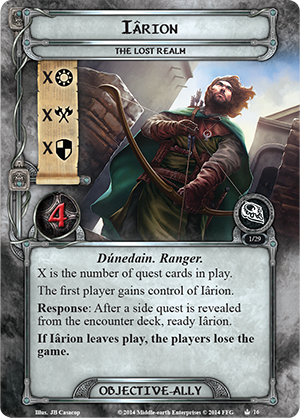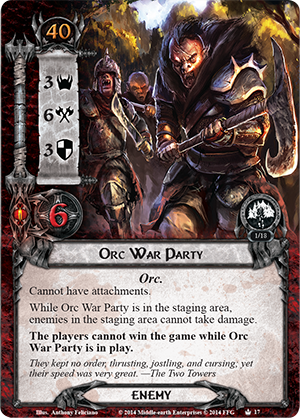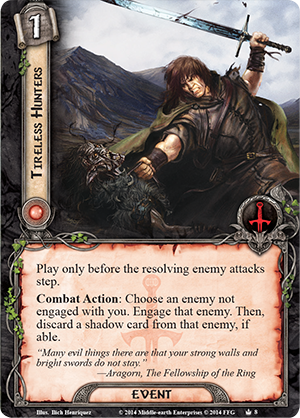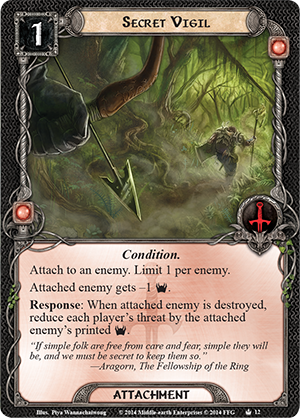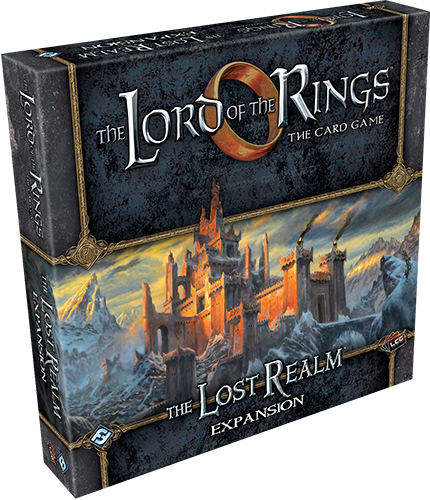
Secret Vigil
A Preview of The Lost Realm Deluxe Expansion for The Lord of the Rings

“In the wild lands beyond Bree there were mysterious wanderers. The Bree-folk called them Rangers, and knew nothing of their origin. They were taller and darker than the Men of Bree and were believed to have strange powers of sight and hearing.”
–J.R.R. Tolkien, The Fellowship of the Ring
Soon, The Lost Realm deluxe expansion for The Lord of the Rings: The Card Game will provide you and your heroes the chance to undertake daring, new adventures in a previously unexplored region of Middle-earth.
Outside the peaceful villages of Bree-land, lies a land tainted by ancient evils. In the darkest, northern reaches of Eriador, the Witch-king of Angmar once ruled. His armies terrorized the region for nearly seven centuries, and though he no longer resides within Carn Dûm, there are other evils that have found their way to Angmar.
In The Lost Realm, you join forces with the Rangers of the North, the Dúnedain who have secretly warded Bree-land and its neighboring villages from the dangers of Angmar and the surrounding lands.
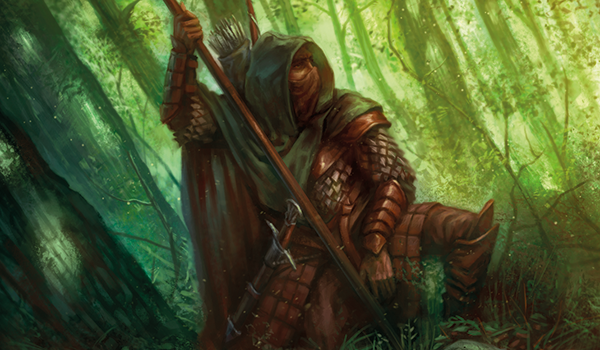
The Orcs Are Massing
Your adventures begin with the expansion’s first scenario, Intruders in Chetwood. When a couple Rangers of the North discover a large group of Orcs making its way toward Bree-land, they realize they need help. The Ranger Iârion (The Lost Realm, 16) asks you to help him intercept the war-party before it can assault the Men of Bree.
Though the Orcs begin with a day’s lead, Iârion proves a skilled tracker, guiding you swiftly through forests and over hills. However, your trials won’t end once you manage to catch the Orc War-party (The Lost Realm, 17); they’ll have only just begun.
At its heart, The Lord of the Rings: The Card Game is about adventures rooted in exploration and discovery. You and your friends work together against a randomized encounter deck full of enemies to fight, dangerous locations to explore, and treachery cards that can snatch victory right out of your hands. Meanwhile, each game immerses you in a story that unfolds as you press forward on your quest, moving from stage to stage. In these ways, The Lost Realm and its scenarios offer as pure an experience as The Lord of the Rings: The Card Game as you could hope to find.
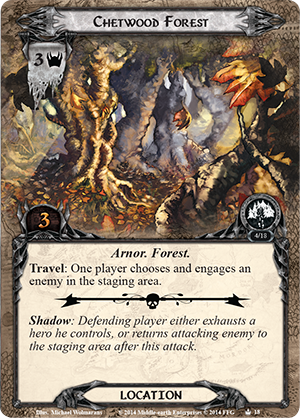 From the opening moments of Intruders in Chetwood, as you hunt the Orcs, through the final quest stage of its final scenario, The Lost Realm immerses you in a narrative adventure full of challenges, choices, and intrigues. In an earlier preview, developer Caleb Grace addressed how the expansion’s side quests add narrative depth, even as they force you and your heroes to choose between pursuing the main quest and ridding the realm of other threats.
From the opening moments of Intruders in Chetwood, as you hunt the Orcs, through the final quest stage of its final scenario, The Lost Realm immerses you in a narrative adventure full of challenges, choices, and intrigues. In an earlier preview, developer Caleb Grace addressed how the expansion’s side quests add narrative depth, even as they force you and your heroes to choose between pursuing the main quest and ridding the realm of other threats.
Along the way, you’ll need to travel from the relative safety of Chetwood Forest (The Lost Realm, 18) to the ruins of Fornost. You’ll learn why Aragorn told the Council of Elrond that the North would have had no peace if not for the Rangers of the North. You’ll learn about the foes he said would freeze lesser men’s hearts, and you’ll face them in battle. Moreover, you’ll have to do all this while trudging onward through foul weather and unmarked wilderness.
The result is that you’ll understand what it’s like to be one of the Dúnedain Rangers. You’ll feel the weight of responsibility sitting squarely upon your back, and yet you’ll continue onward, because there is no good alternative. You will gain no fame nor fortune should you succeed, but if you fail, many innocent men and women will die.
The Tireless Hunt
Of course, The Lost Realm explores the Rangers of the North and their trials in more ways than one. The expansion introduces two new Dúnedain Ranger heroes, a host of new Dúnedain allies, and a handful of related events and attachments.
As we’ve already seen, many of these new cards focus on scouting out enemies and engaging them, and this means that The Lost Realm adds a new dimension to the Tactics sphere of influence, even as it bolsters the Dúnedain trait.
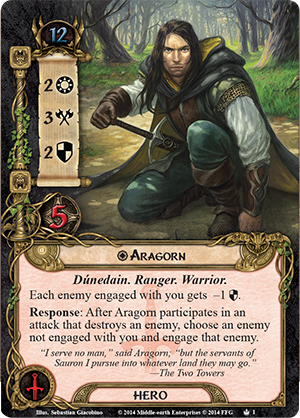 Each sphere of influence has its strengths and weaknesses, and in multi-player games, Tactics players will often protect other members of their fellowship from as many enemies as possible. For starters, then, Tactics players frequently aim to optionally engage enemies as often as possible, and they often play with threat levels that are slightly higher than the rest of the table, so that they will be the first targeted by enemies in the engagement phase.
Each sphere of influence has its strengths and weaknesses, and in multi-player games, Tactics players will often protect other members of their fellowship from as many enemies as possible. For starters, then, Tactics players frequently aim to optionally engage enemies as often as possible, and they often play with threat levels that are slightly higher than the rest of the table, so that they will be the first targeted by enemies in the engagement phase.
Often, though, you’ll find yourselves facing situations in which multiple enemies enter the staging area at once, and your Tactics player can’t engage them all. These situations occur frequently enough that many Tactics players feel the need to incorporate Ranged and Sentinel characters, as well as events such as Feint (Core Set, 34), in order to help their friends across the table.
Soon, The Lost Realm will introduce new means of controlling the game’s enemies and engagements, and this means that Tactics players will be able to pursue a wide range of all-new, effective deck-building archetypes.
The new Tactics version of Aragorn (The Lost Realm, 1) is likely to be the lynchpin in many of these builds. Not only does he subtract one from the Defense Strength of every enemy engaged with you, he comes with a Response ability that can pull enemies away from other players:
“Response: After Aragorn participates in an attack that destroys an enemy, choose an enemy not engaged with you and engage that enemy.”
Some of Aragorn’s benefits are obvious. By offering a consistent and immediate means of pulling enemies away from your fellow players, Aragorn’s ability grants you new freedom in the construction of your deck and the selection of your heroes. You face less need than ever to include Ranged characters or cards like The Hammer-stroke (The Blood of Gondor, 111) in order to attack those enemies that engage your fellow players.
Some of Aragorn’s benefits are less obvious, but no less effective. Since Aragorn’s Response isn’t a Combat Action, it works anytime he participates in an attack that destroys an enemy. That means that he can use cards like Quick Strike (Core Set, 35) to attack and destroy enemies before other enemies attack your teammates, and in this way, you can be an effective teammate and combatant, even if you don’t include Sentinel characters in your deck.
To this end, The Lost Realm also introduces Tireless Hunters (The Lost Realm, 8), which for one resource serves both as a Sentinel replacement and as shadow cancellation.
Finally, even as it offers Tactics players a range of new freedoms, The Lost Realm provides them with some limited, thematic means to explore an entirely new role – threat reduction. For a single resource, Secret Vigil (The Lost Realm, 12) can attach to an enemy and reduce its Threat Strength by one, making it easier to quest successfully so long as that enemy remains in the staging area. Then, once that enemy is destroyed, Secret Vigil reduces each player’s threat by an amount equal to the target enemy’s printed Threat Strength. When you consider that The Galadhrim’s Greeting (Core Set, 46) costs three resources for a table-wide threat reduction of two, you’ll be especially thankful for the Dúnedain and their Secret Vigil, especially when they eliminate an enemy as threatening as an Angmar Marauder (The Lost Realm, 44).
Explore the North
Will you experiment with a Dúnedain deck, or will you rely upon other heroes as you face the perils of the North? Either way, The Lost Realm offers an immersive and perilous exploration of one of Middle-earth’s most intriguing realms, the dark and shadowy lands just outside of Bree-land and the Shire.
The Lost Realm is now just a few weeks away. In the meantime, stay tuned for more news, including a look at the expansion’s second hero and a pair of sample Dúnedain decks designed to work together!
…

